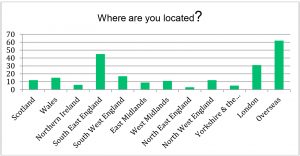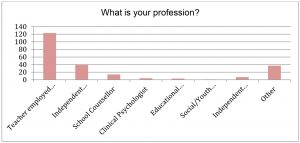A big THANK YOU to all Hub members who completed our trained teacher survey this Spring. We had 228 responses from 1,950 members, a response rate of 11%, from which we are able to get a better picture of the implementation of our curricula in schools. This is what you told us:
1. You enjoy teaching our curricula, and are confident in doing it:
- ‘The lessons are a joy to teach’
- ‘I love teaching it and get so much myself from delivering the programme’
- ‘Increased familiarity with the course leads to increased confidence on my part’
2. You recognise the benefits of teaching mindfulness in school:
- 82% of teachers felt their pupils got a “great” or “good” deal of benefit from the course they were part of.
- No teacher considered that their pupils got “little or no” benefit.

3. You appreciate the quality of our materials
(but would like us to keep updating it to make it relevant and flexible to your school’s context):
- ‘The teaching manuals & resources are excellent. They help a great deal in making sure all our trained MiSP teachers are working towards the same goals with a consistent approach’
- ‘I wasn´t sure about the amount of slides, I felt it a bit too much, but the students loved it. So I´ve stuck to the slides and just added my own thoughts sometimes due to my experience.’
- ‘Teaching to students in inner London I felt the material could be more inclusive. Had to omit certain video clips that seemed to be pitched at white kids’
- ‘We are a sixth form only, and some of the feedback from the students was that the materials used were somewhat childish’
- ‘.b’ needs to be taught in a minimum of 45 minutes, but I had only 30 minutes slots when integrated in PSHE’
- ‘I also think it would be beneficial to have some simple, short exercises that would work with kids who have not been through the full program’
4. You struggle to find curriculum time to teach mindfulnes:
- ‘Time in curriculum for teaching initial lessons and daily practise, working around other teachers timetables for swapping classes, children being out for other activities at that time’
- ‘Finding a free slot in an already overloaded curriculum’
- ‘Time, space and competition with curriculum demands are the main obstacles’
- ‘That I am only able to deliver it in tutor time – so I have to split the lesson time twice a week’
- ‘Time for me to catch up. I use my non contact time to deliver the lessons’
5. You don’t always have buy in from the school leadership team or other colleagues:
- ‘The reluctance from the management to acknowledge its benefits’
- ‘Convincing students and staff that it is of value even if it doesn’t lead to an academic qualification’
- ‘Wider acceptance by other staff and the absolute plethora of mental well-being initiatives that each claim to be the best’
- ‘Bringing on board some teachers who seemed to think they did not need to take part’
- ‘Busy teachers still perhaps not understanding and seeing it as one extra thing they have to fit in’
- ‘Honouring the time it takes to embed in a school, most schools want to run before they can walk …and don’t honour the depth of practice that is needed’
6. You sometimes experience disruptive behaviour and some of you advocate an opt-in model rather than a mandatory model:
- ‘I find that about half of the class is engaged and the other half doesn’t want to be there. As Mindfulness is not assessed subject some students can’t see the benefit of learning it’
- ‘Year 7s – some can be very immature and giggly in a class setting – can ruin it for those who want to take it more seriously’
- ‘Main challenges are children who choose not to join in or distract others’
- ‘It can never be as good for every member of a ‘conscript army’ as it would be if all students were participating out of choice!’
7. Funding remains a core issue:
- ‘My own school cannot release me to teach any more mindfulness due to cost of covering my class. Other schools often want free sessions as they do not have a budget for it’
- ‘Funding can be a barrier as budgets are getting cut all the time’
- ‘Competition with other well being initiatives being introduced to the school that all teachers can teach’
8. You can feel isolated as the only mindfulness teacher in your school:
- ‘I am the only person delivering it . It is taking time to involve other staff and many have a very negative attitude to mindfulness or are completely overtaken by their own curriculum’
- ‘Feeling isolated as a .b teacher. Not always feeling confident about my teaching and not having opportunities to plan with colleagues’
- ‘I sometimes feel invisible teaching mindfulness as other staff don’t even know that mindfulness has been taught in school’
9. You value being able to point your students to online meditations via dotbe.org (but recognise students do not all choose to do home practise).
Some of you think a MiSP app would help:
- ‘Home practise website is great for students to complete in a different environment eg in their bedroom or with their family or with a sibling etc or sit in the garden – helps it to be portable or show students that it is portable’
- ‘I think that there is a lack of students engaging with the Home Practice… I would say this maybe a third of the students in the group’
- ‘An app with meditations you can listen to for free – the website is too much of hassle for them to log into!’
10. You had some wonderful, memorable moments from your teaching in schools:
- ‘One of our students asked me several times “what was that? what is it called?” He was referring to the beditation… He said it “that was amazing that”, it was “boss”’
- ‘It is always lovely to hear the pupils discuss their feelings and see their joy on discovering they suddenly understand their feelings’
- ‘Teachers breaking down in tears and experiencing some relief at being able to talk about not coping’
- ‘Seeing how the more challenging students engage throughout the course. From being cheeky, sarcastic, and sometimes rude to fully engaged, excited, enthusiastic members of the class. Seeing the quiet and shy students finding their voice and being seen and listened to by their class. How the class grows as a group, seems to knit them together in some way’
- ‘One child who can be very anxious told the class about his worries snowballing when his mum was late and he thought that she had crashed her car, and he has since told me that he can catch his snowballs now sometimes before they get bigger’
- ‘A student with anger management issues came to me for a few sessions, in which I taught him 7/11 breathing. A few years later he was visiting the school as a past pupil, having recently signed as a professional footballer in England. When asked if he learned anything useful during his time at the school, he replied “the counsellor guy taught me this breathing thing which I use during matches and I’ve never lost my cool since, never got sent off again which was always happening”’
- ‘When children come and tell you that they have used a practice in the playground to help them calm down, are getting on with their siblings better as they understand their perspective more etc. it’s always wonderful to hear’
- ‘Hearing from exam stewards that students were doing .b’s and fofbocs before going into Leaving Cert. exams (the Irish A level equivalent) 2 years after having received the .b teaching’
- ‘The NHS vaccinations team recently commented on how much calmer our 3rd year pupils were when getting two vaccinations at the same time. The were all doing a .b and they asked what that was!’
- ‘When the last person out of the classroom whispered to me: Sir… this stuff really works’
11. About you:

- 41% of you are from the South of England, 32% from elsewhere in the UK and 27% of you are from overseas

- 54% of you are teachers employed in a school. The rest of you are independent mindfulness teachers (17%), counsellors, psychologists, therapists, school nurses etc.
- 52% of you are trained to teach .b, 31% Paws b, 12% .b Foundations and 4% School Mindfulness Lead
- 10% of you have not yet delivered our curricula since your training
- You teach our curricula in a wide variety of settings
- In Primary schools, secondary schools, 16-18 colleges, post 18 settings,
- In form time, tutor groups, pre-schools sessions, lunchtime clubs, bespoke groups
- In state-maintained schools, independent schools, special schools, alternative education providers, prisons, summer camps, CAHMS, clinical settings, church and community learning and to private students
- To date, on average those of you who have taught are curricula have taught 7.b courses each, 5 Paws b or .b Foundations courses each
- On average, each of you has taught 126 children and young people since you were trained to teach MiSP curricula